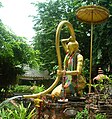Thorani

Thorani or Vasu (n) dharā is a Buddhist earth goddess who is worshiped in parts of Southeast Asia .
According to legend, she was present when the Bodhisattva ( Siddhartha Gautama , who later became Buddha) attained enlightenment. She is said to have helped the Bodhisattva against the evil demon Māra , who wanted to keep him from enlightenment. She wrung streams of water from her hair, which Māra and his army washed away.
The figure plays a role in the folk religion of the Theravada Buddhist countries of Cambodia , Thailand , Laos , Burma and the southern Chinese district of Xishuangbanna (Sipsong Panna). However, it is not detectable in the religious texts of Theravada Buddhism. They only say that the Bodhisattva, while struggling with the evil demon, touched the earth and called as a witness against Māra. This is probably the starting point for the formation of the figure of Thorani.
In the Buddhist iconography of Southeast Asia, Thorani is often depicted kneeling at the base of the vajrāsana , the throne on which the bodhisattva sits while he attains enlightenment. In some pictures she wears the vajrāsana on her head. Thorani is accompanied in many depictions by her attribute , a crocodile .
annotation
- ↑ The name of the deity varies from country to country. In Thailand it is known as พระ แม่ ธรณี ( RTGS : Phra Mae Thorani, pronunciation: [pʰráʔ mɛ̂ː tʰɔːráʔniː] ) or นาง ธรณี (Nang Thorani, [naːŋ tʰɔːráʔniː] ), in Cambodia as Preah Thorani or Neang Kong Hing . The Burmese and Arakanese use variations of the name in Pali (Vasundharā), e.g. B. Wathundaye or Vasundari
gallery
Mural in Wat Phnom in Phnom Penh , Cambodia.
Phra Mae Thorani fountain in Bangkok , Thailand.
literature
- Elizabeth Guthrie: A Study of the History and Cult of the Buddhist Earth Deity in Mainland Southeast Asia. Dissertation, University of Canterbury, Christchurch (New Zealand) 2004.


